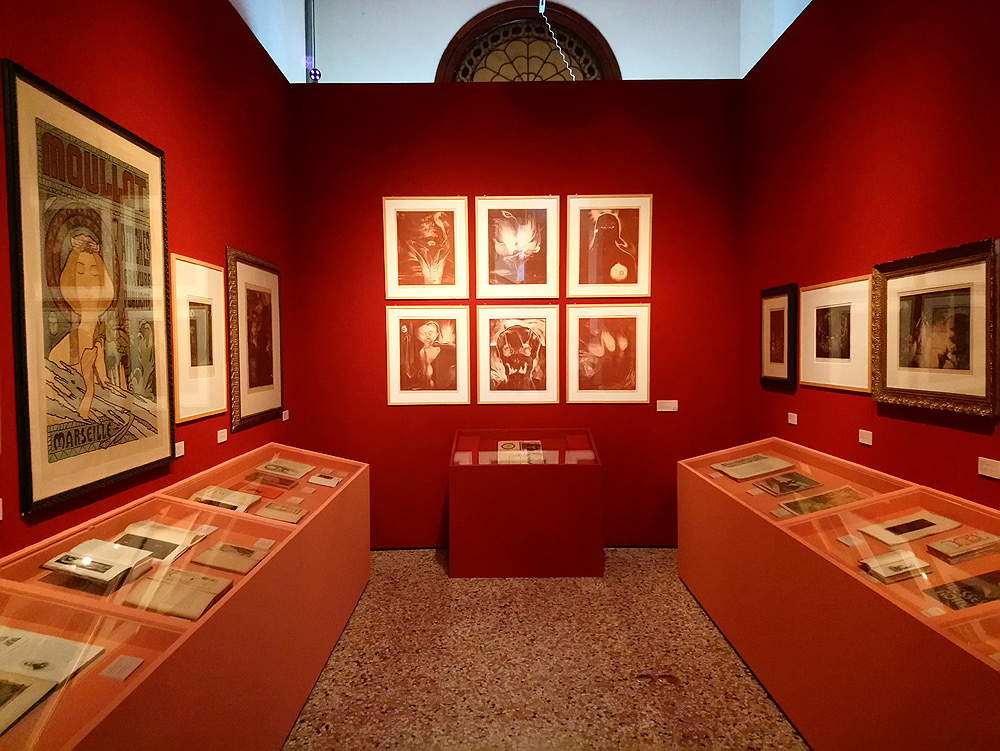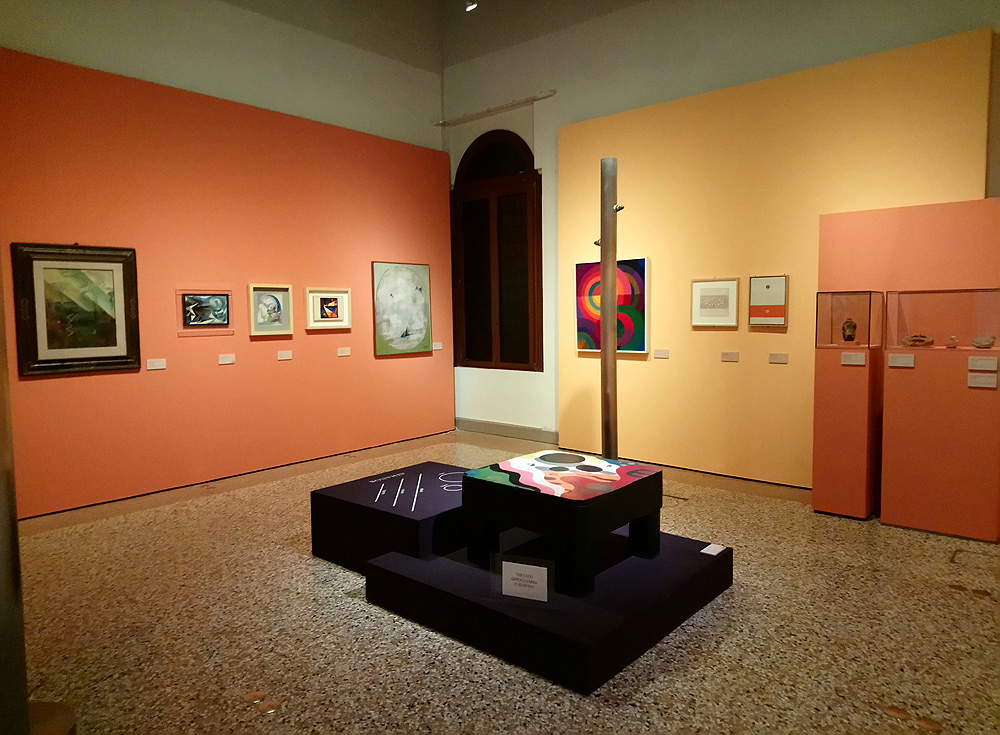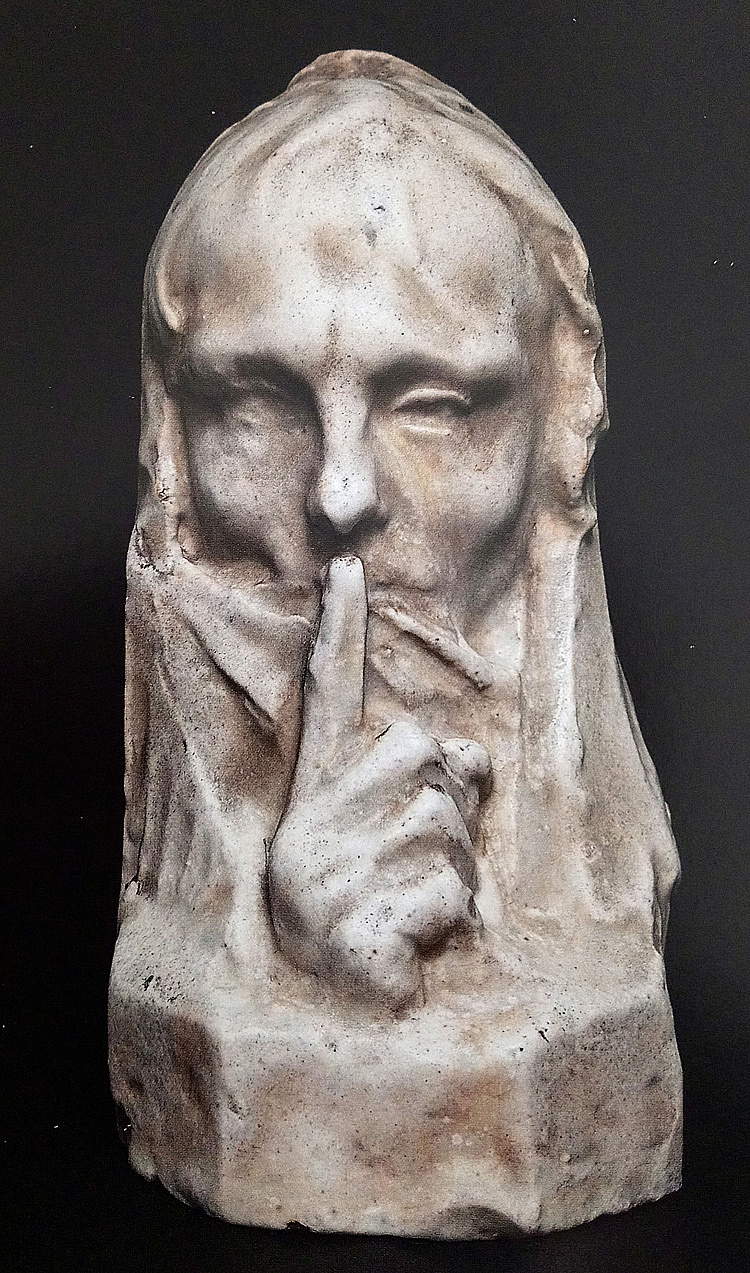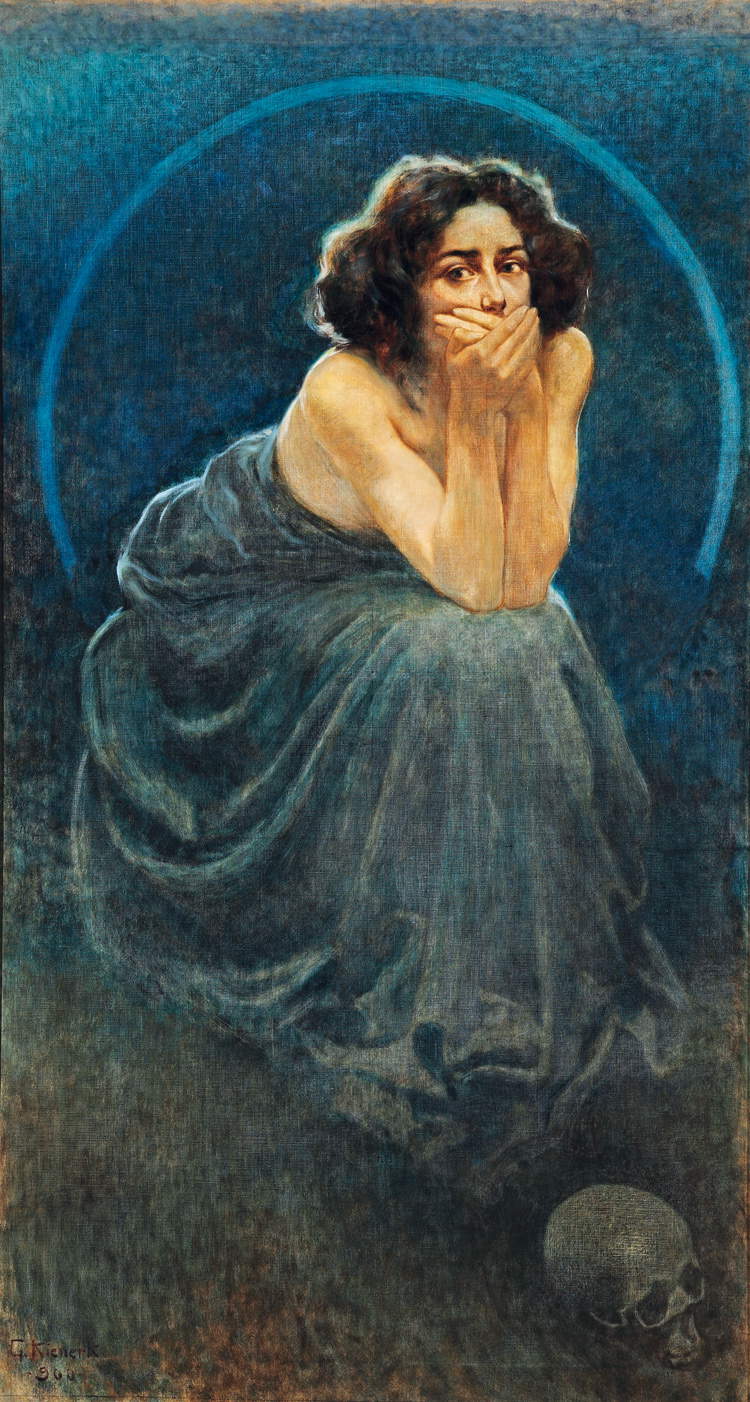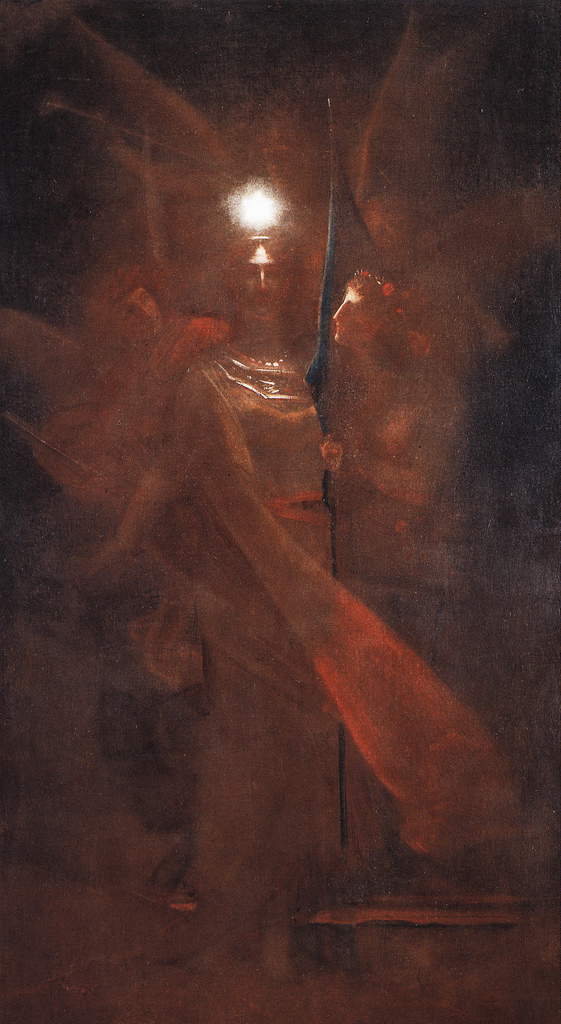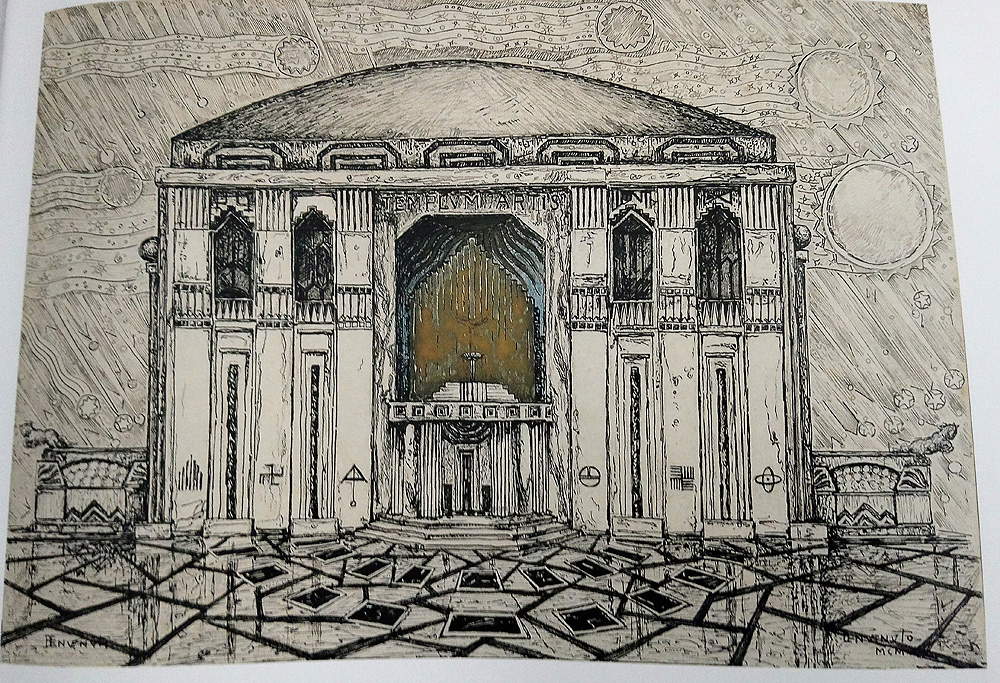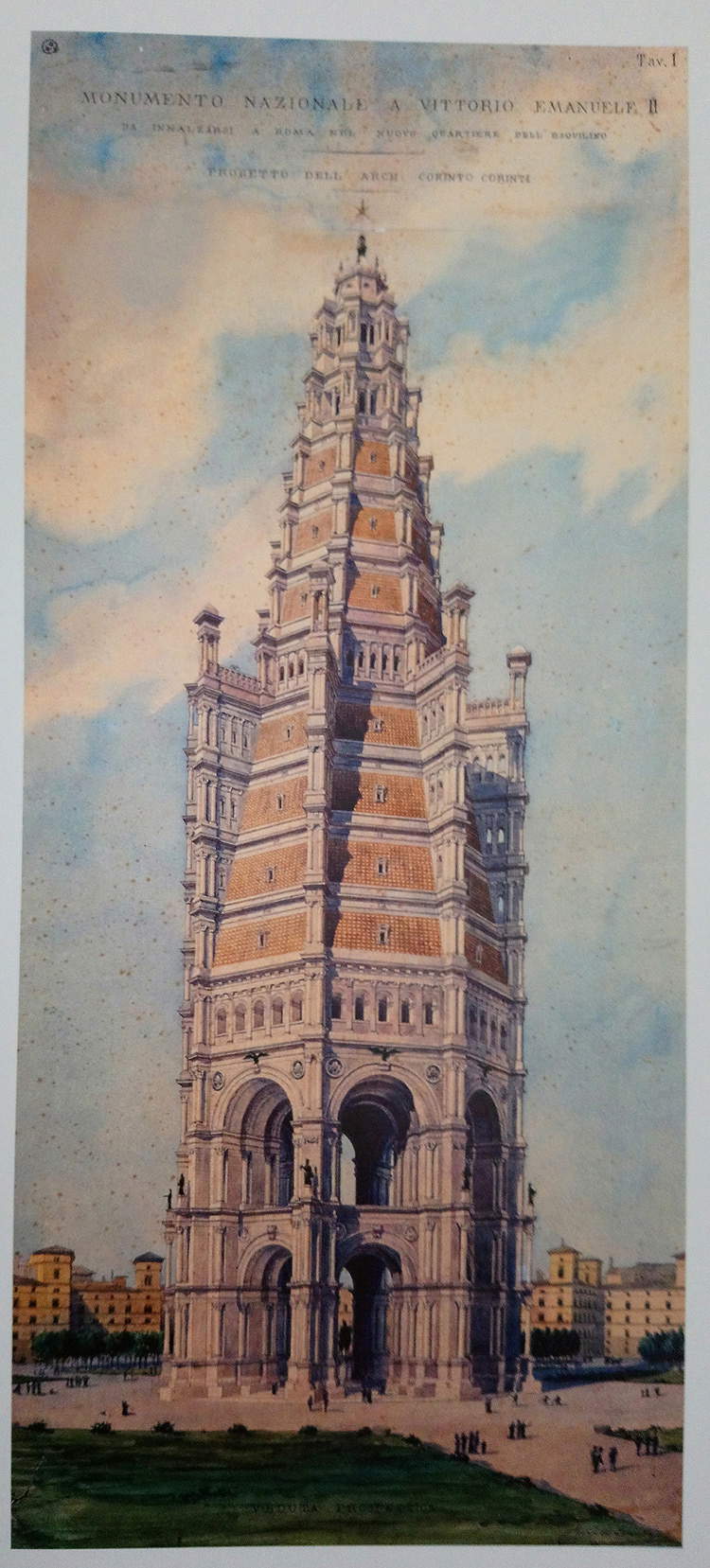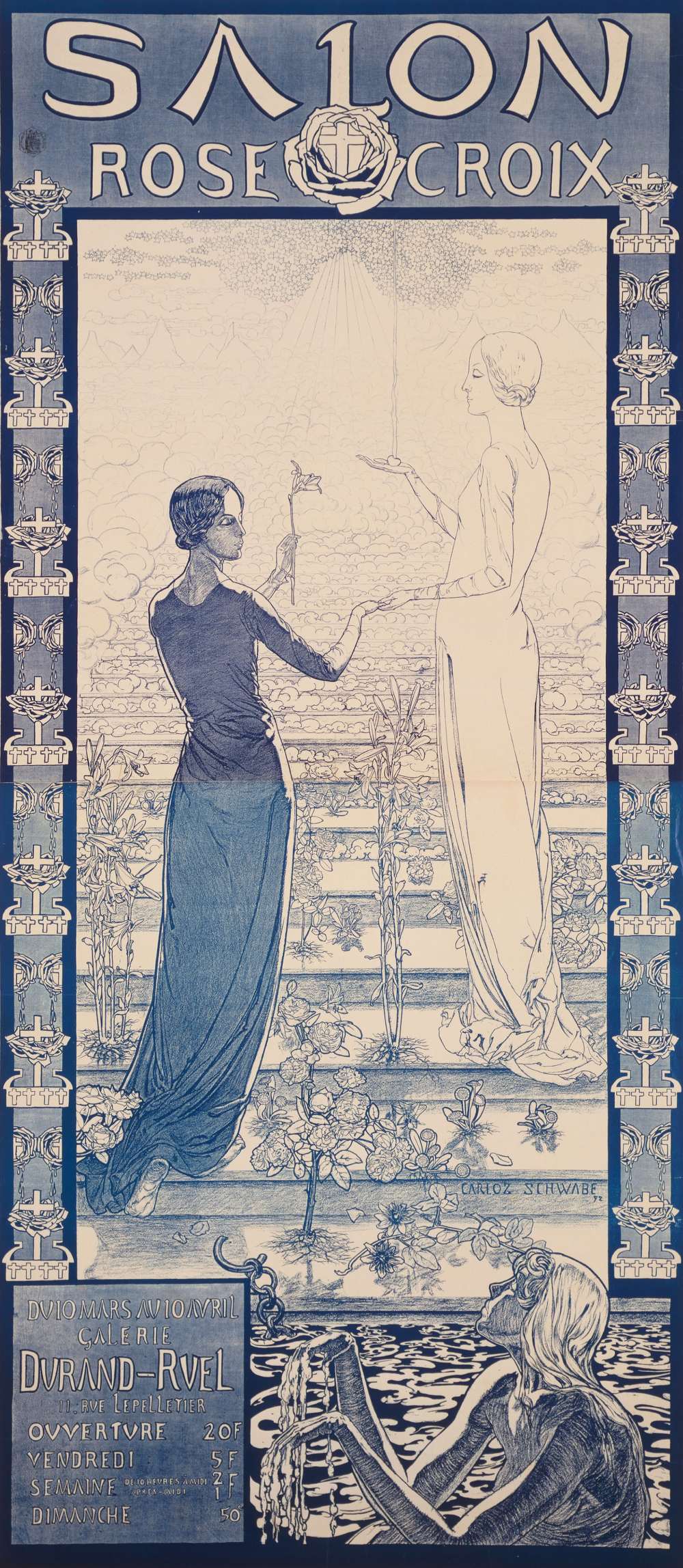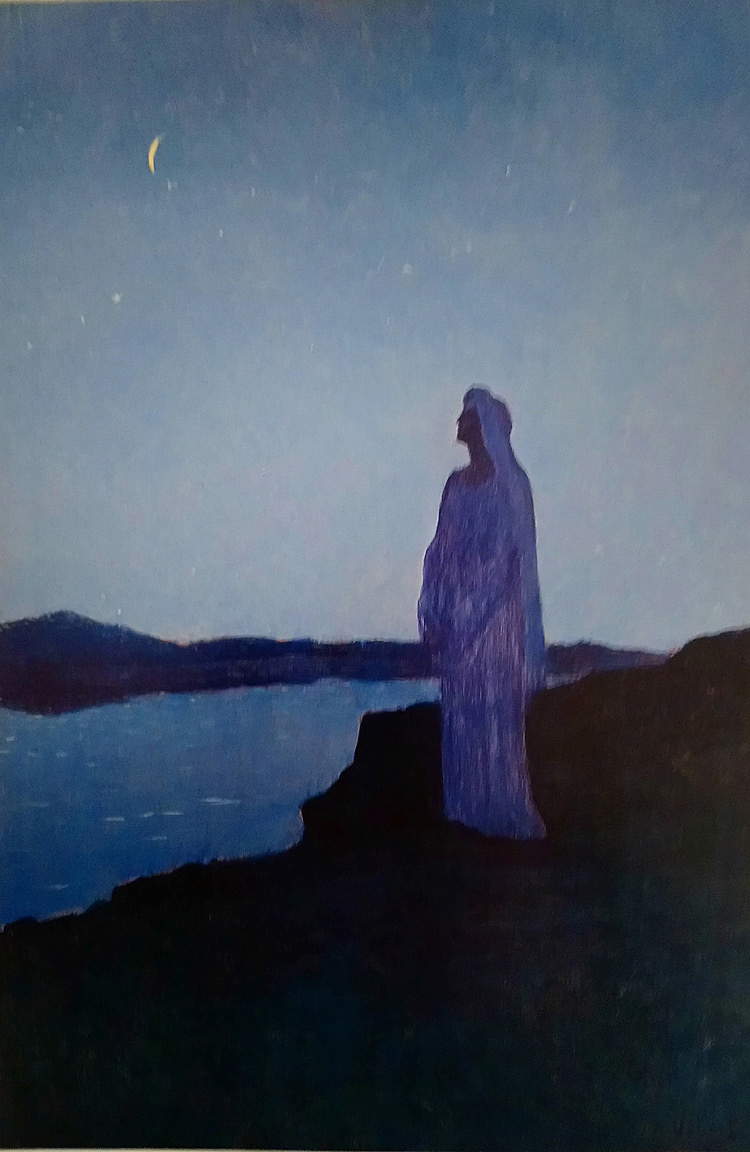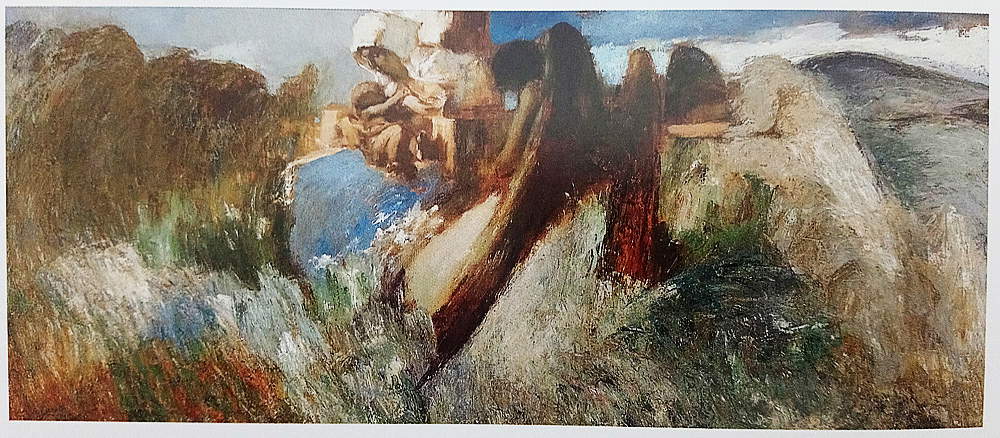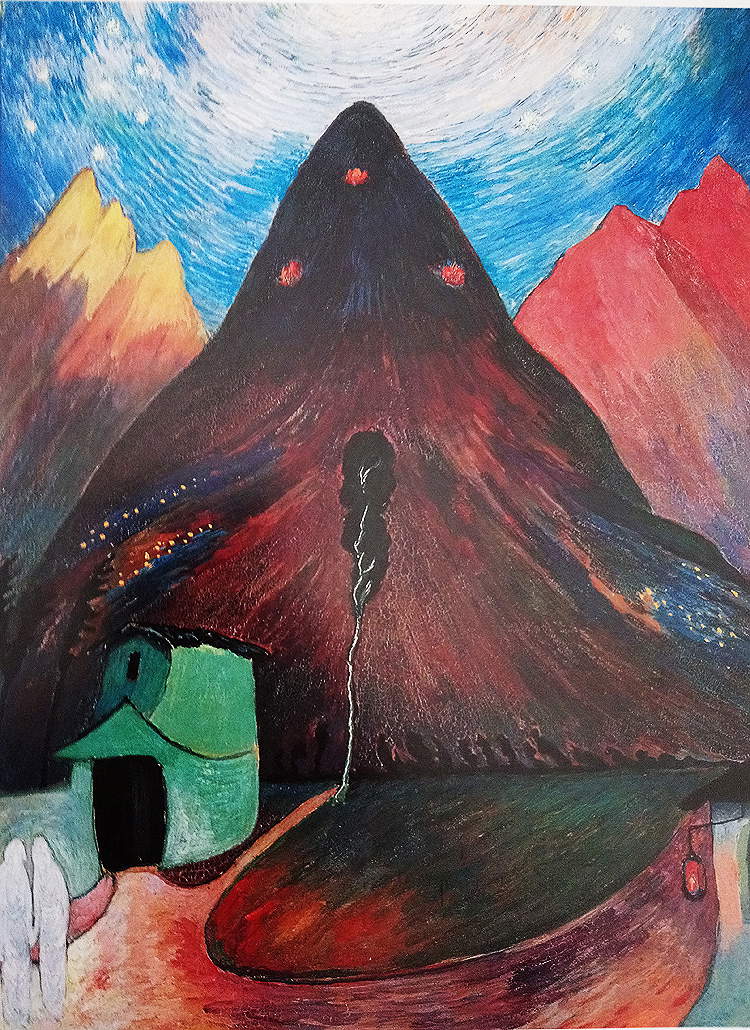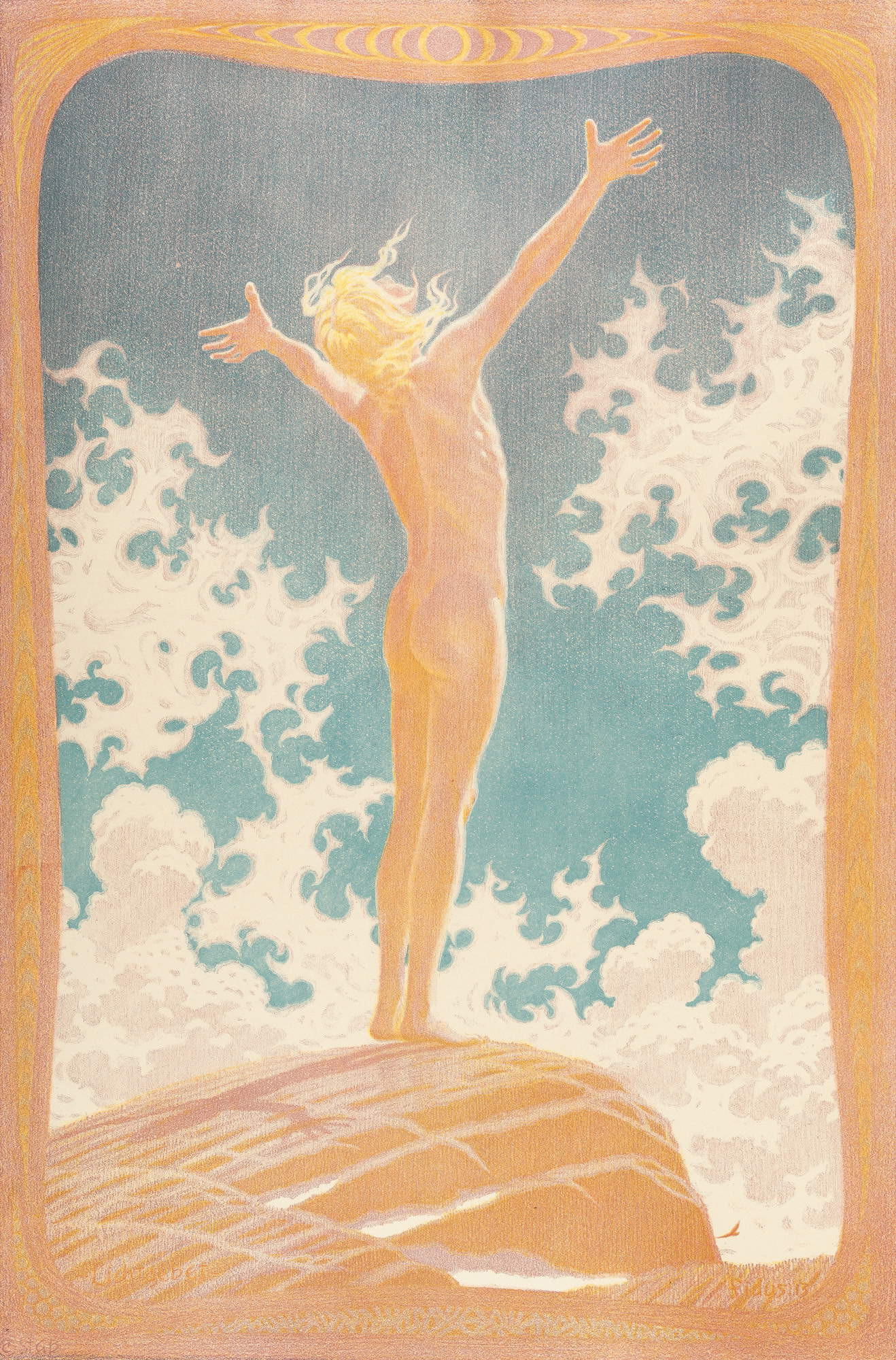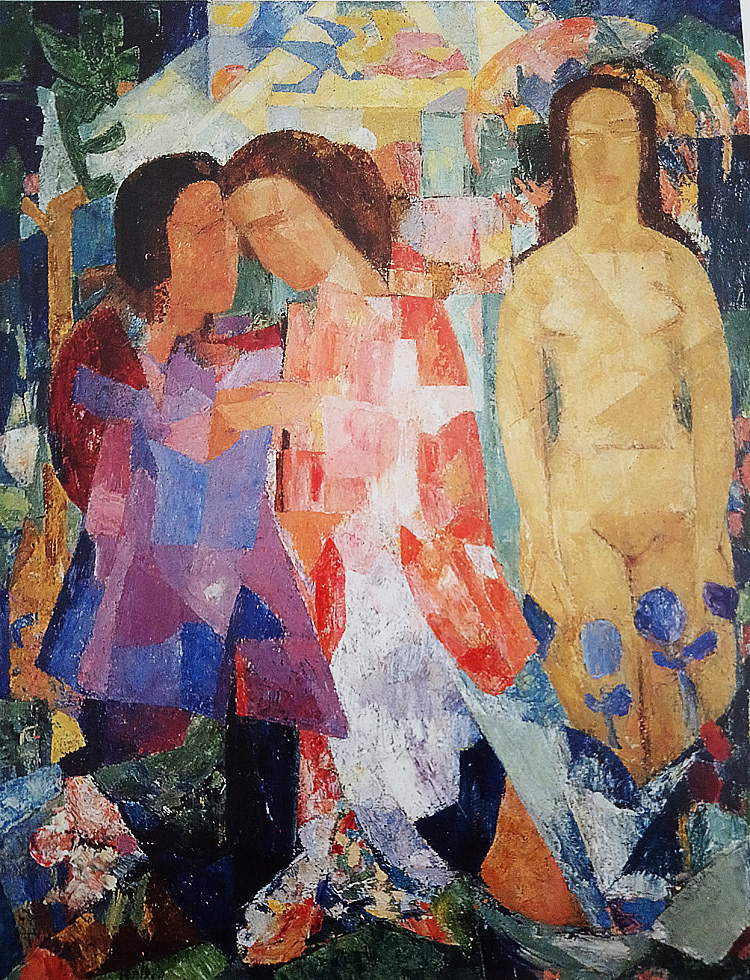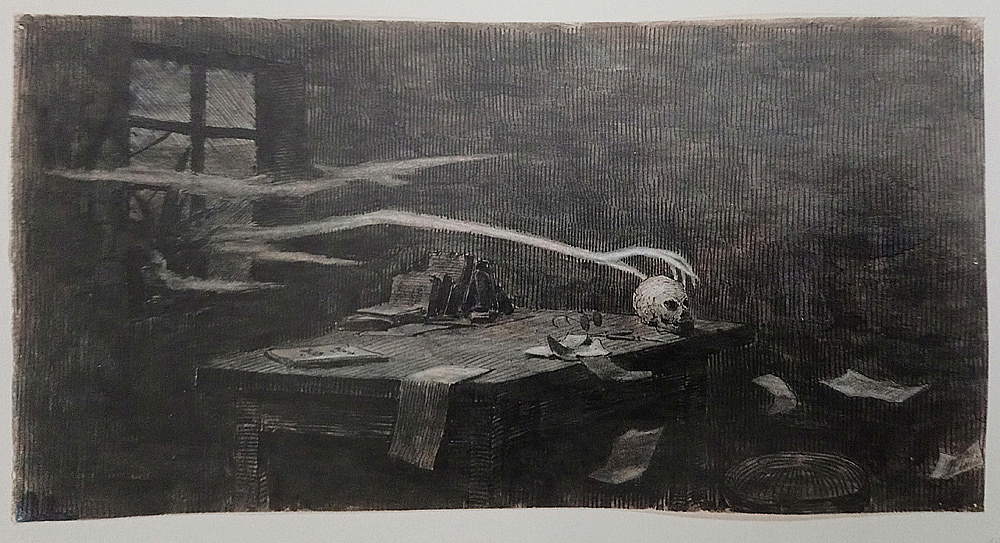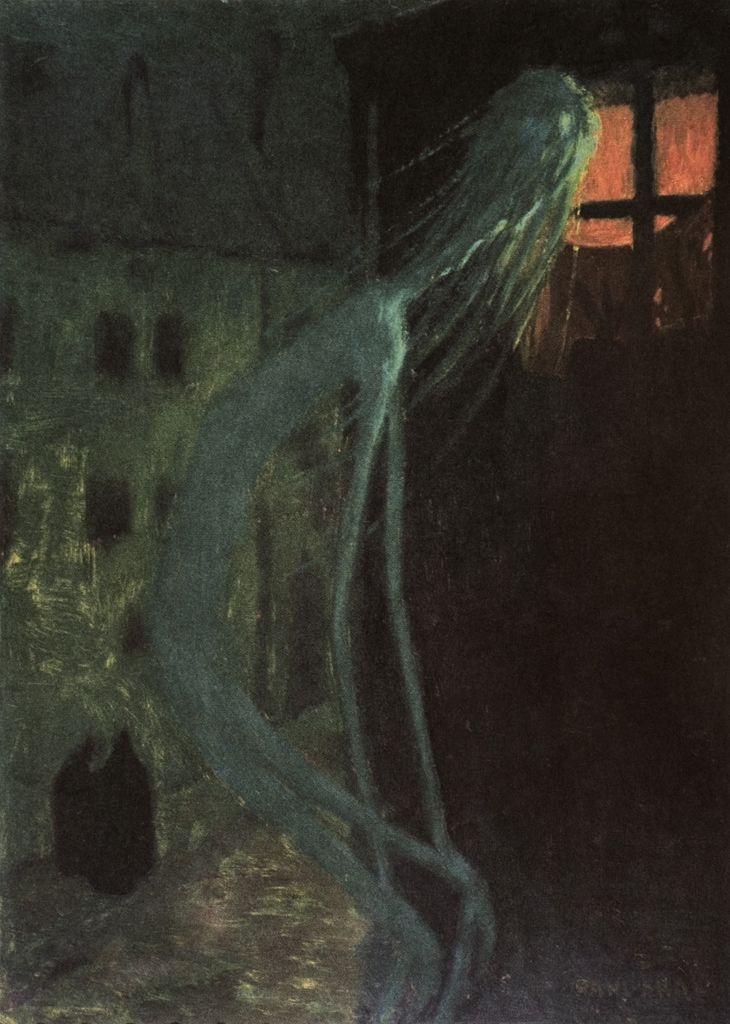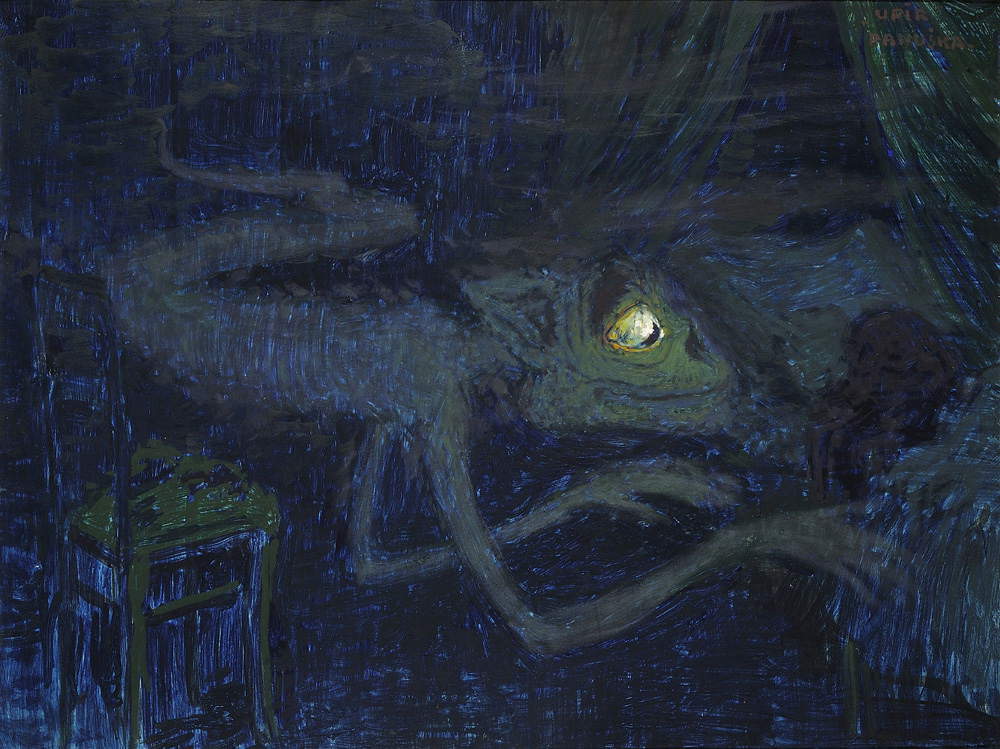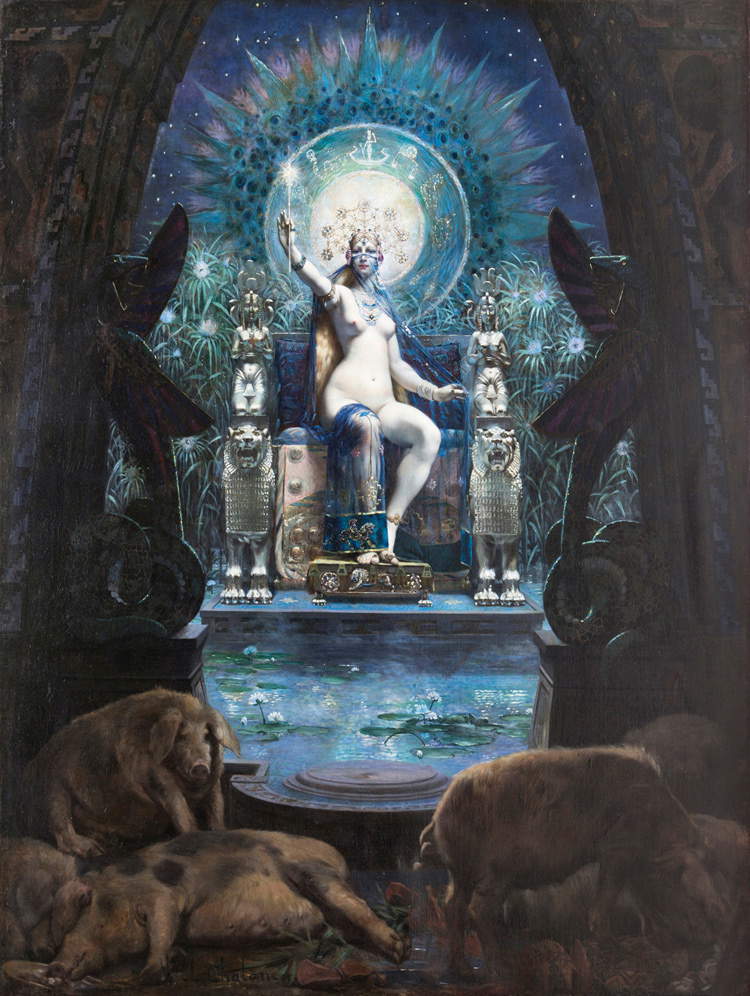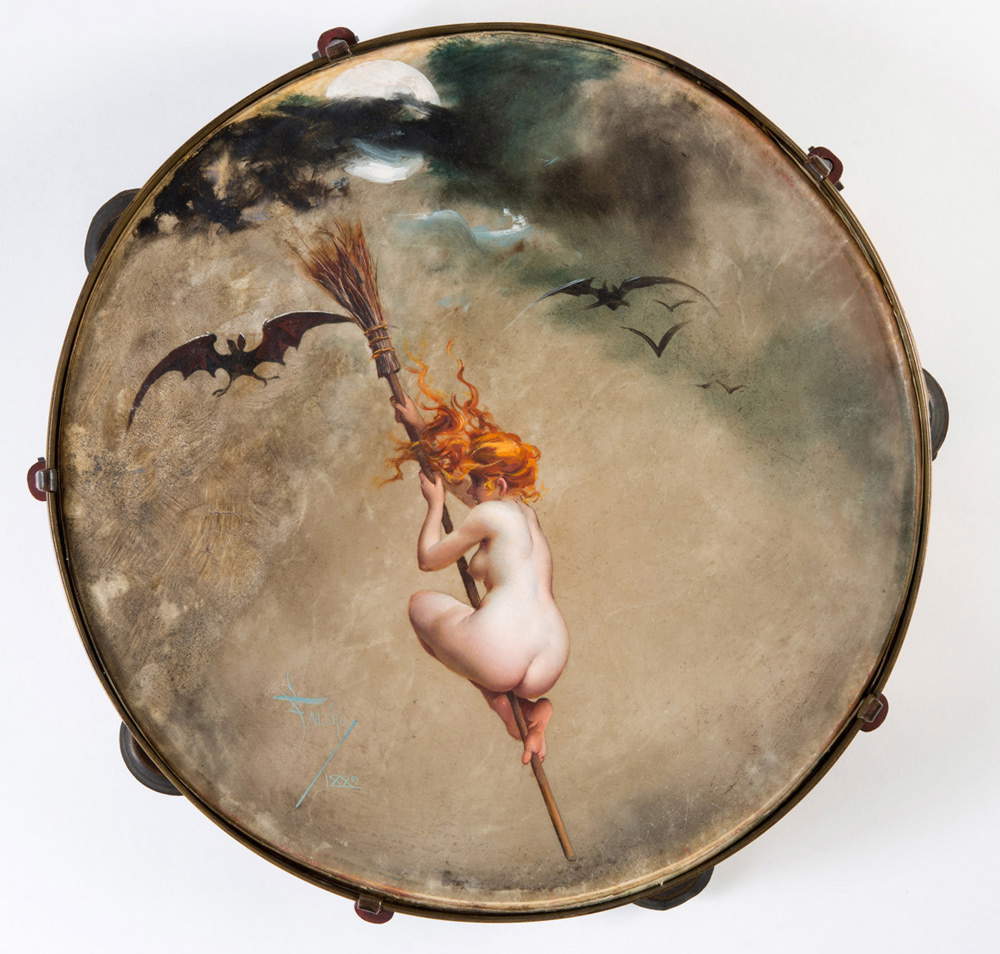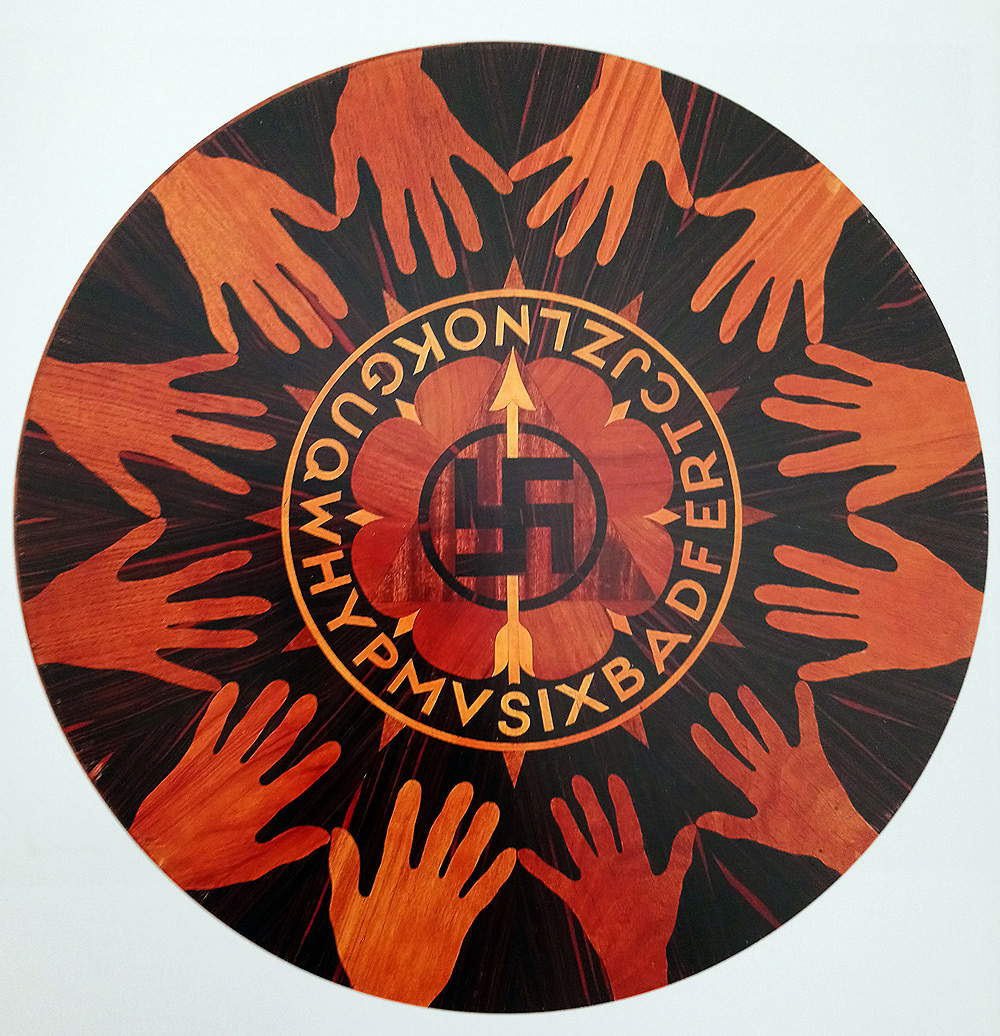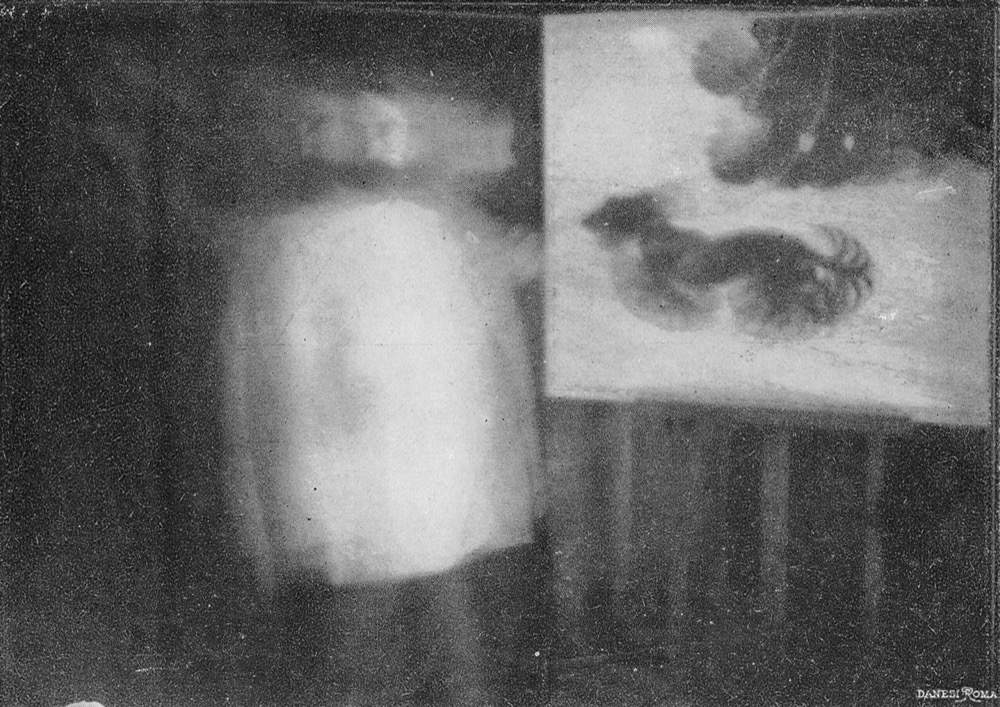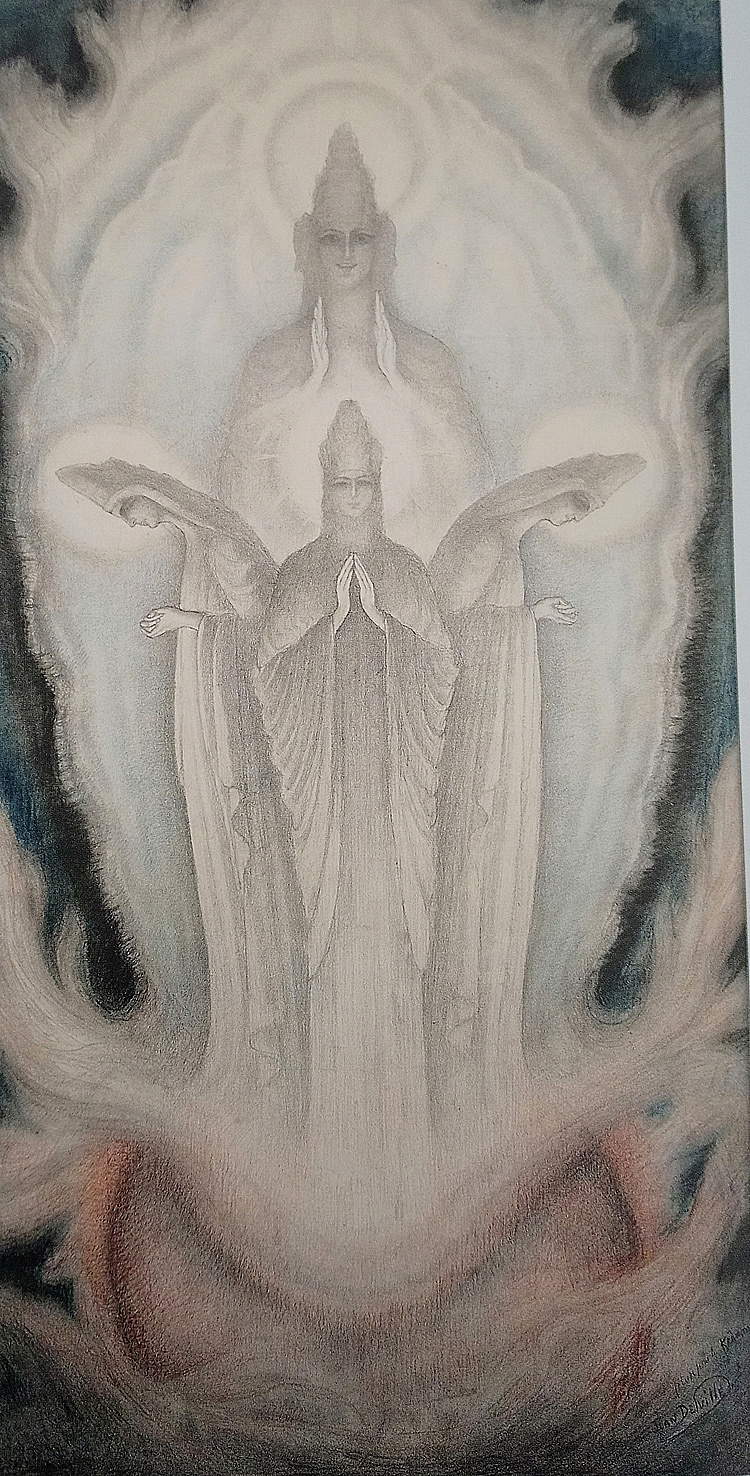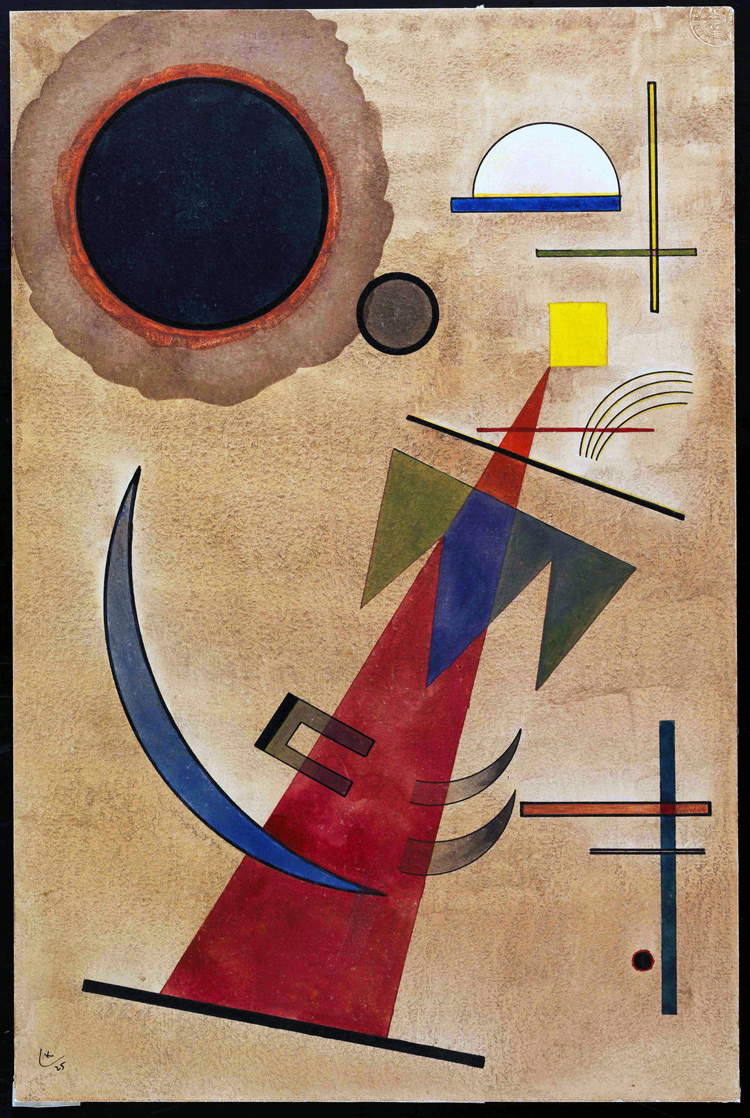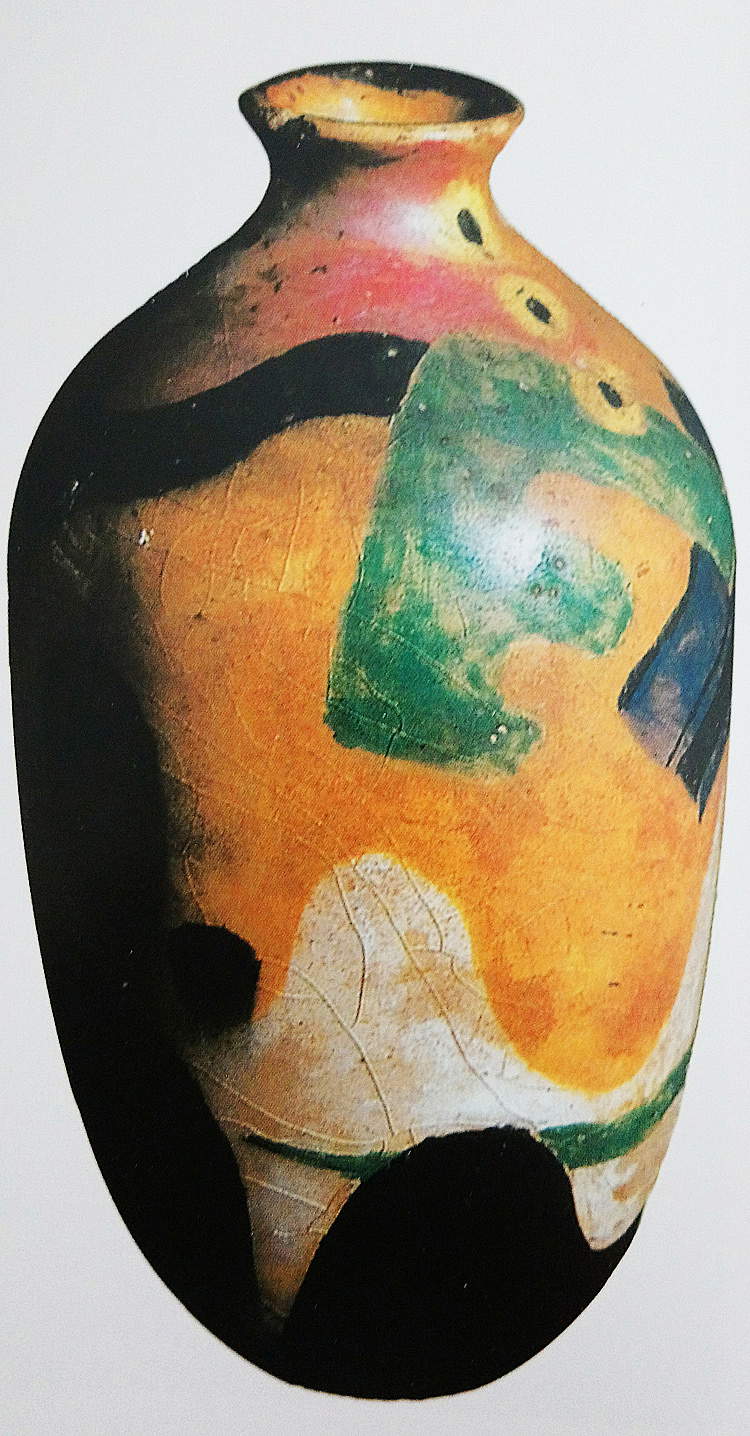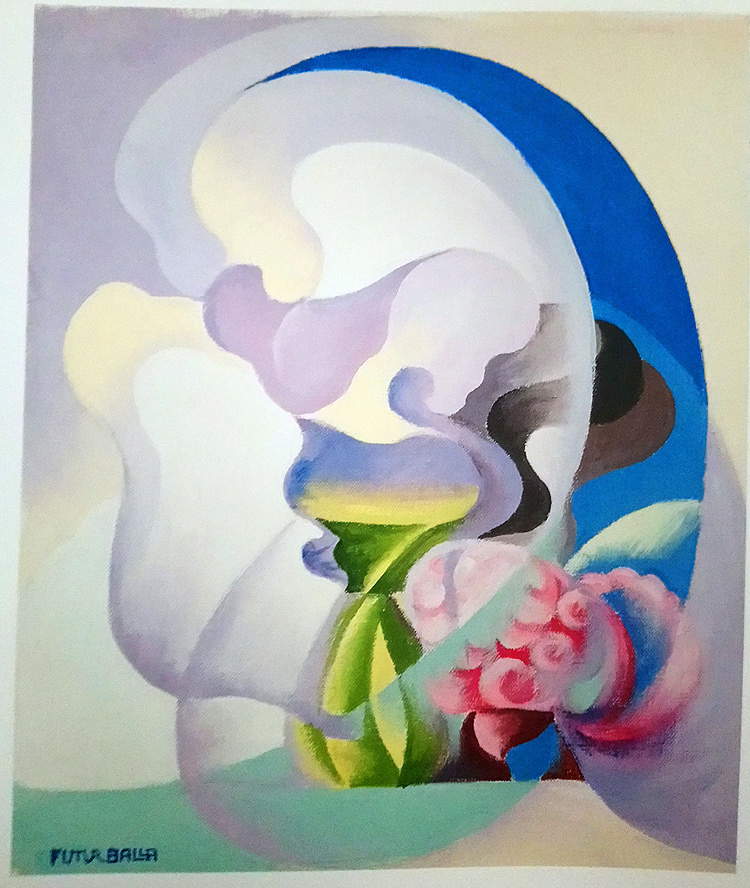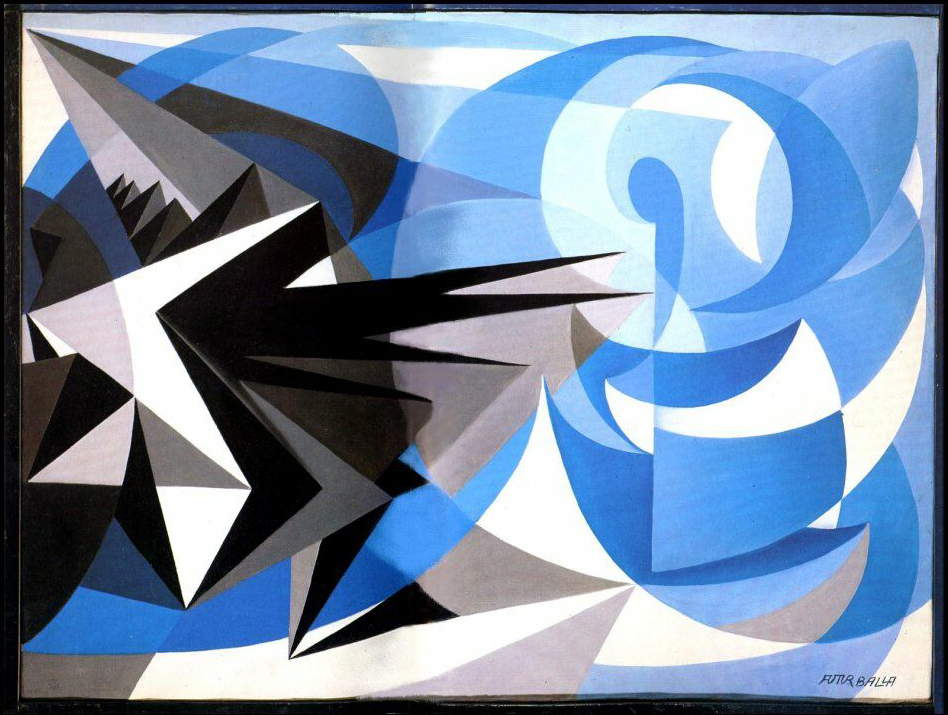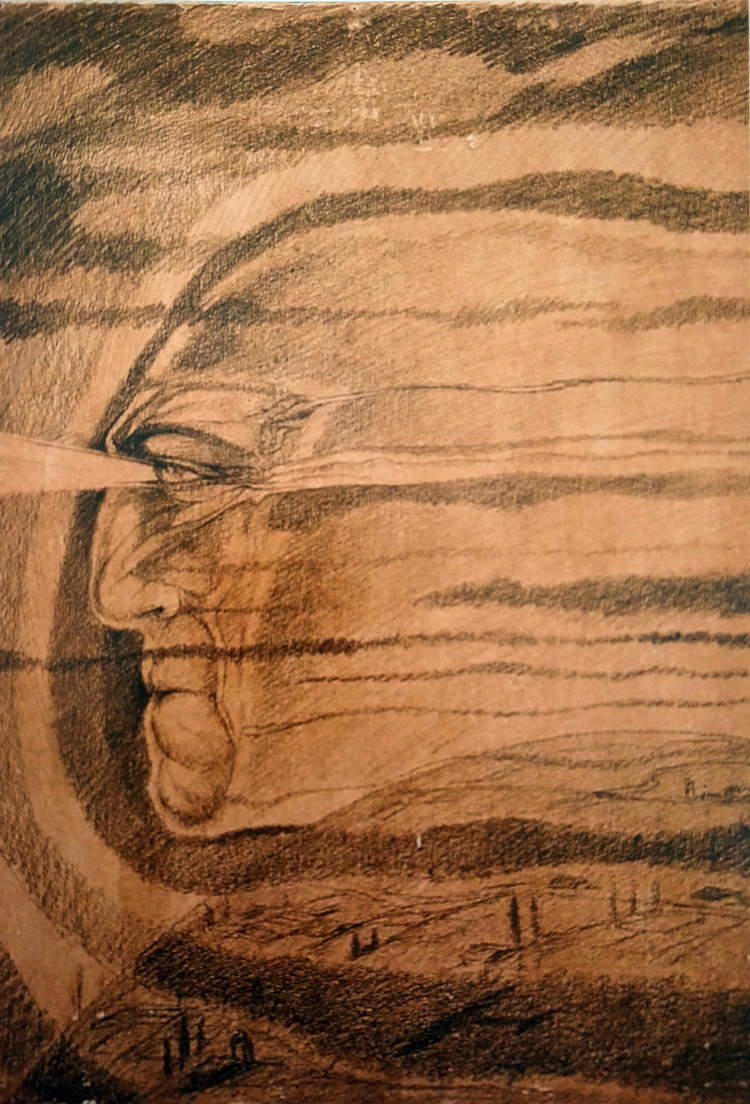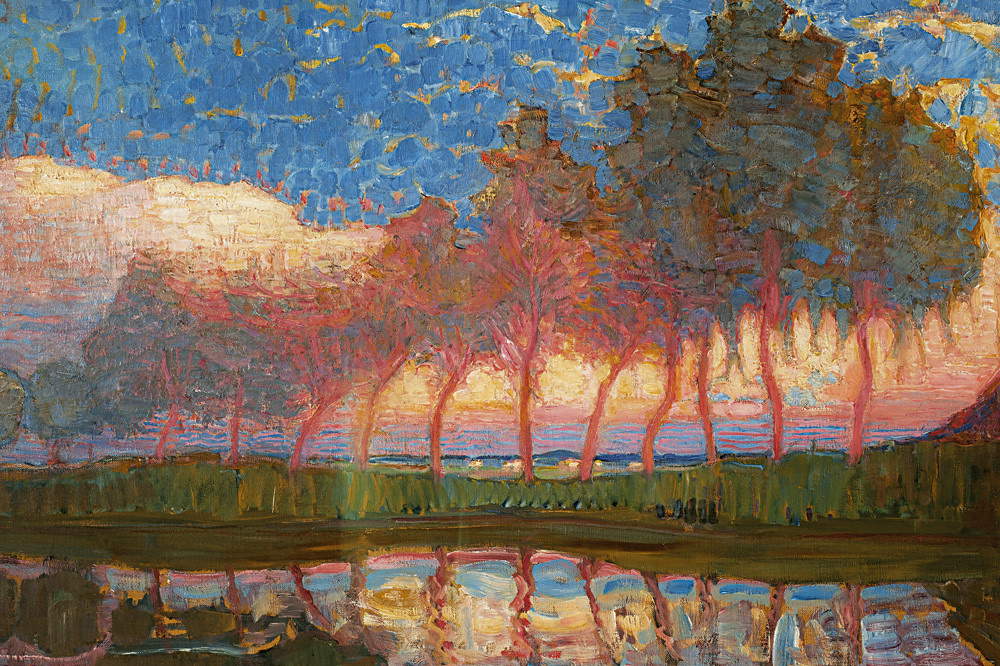by Federico Giannini (Instagram: @federicogiannini1), published on 18/11/2018
Categories: Exhibition reviews
/ Disclaimer
Review of the exhibition 'Art and Magic' in Rovigo, Palazzo Roverella, from September 29, 2018 to January 27, 2019
In his Attic Nights, the Roman writer Aulus Gellius, who lived in the first century of the common era, reported that all young men eager to approach the teachings of Pythagoras were required to observe at least two years of silence: the disciples whom the great philosopher accepted into his school, Aulus Gellius assures us, were to listen to the words of the master, and could not ask questions if they understood little, let alone comment. Only after learning all the topics, even the most difficult ones, were they allowed to express themselves, to utter a few words, to ask. That silence that Pythagoras imposed would later traverse the centuries, rising as a symbol of meditation, of the primary passage for being initiated into a doctrine, a cult or a philosophy, as well as of the effort required to learn. “In ancient times,” D’Annunzio wrote in his Secret Book, “religions and philosophies did not live except by silence: they knew and observed the necessity of silence. Those that shirked that necessity, those were always misunderstood deformed profaned disheartened.” There is the silence of the Christian anchorite, who silences himself to better accommodate his god, and for certain monastic orders silence is part of the rule to be obeyed. There is the silence of Freemasonry, more akin to the Pythagorean silence, which apprentices who intend to enter the next degree of the Masonic hierarchy are obliged to. There is the silence that philosophical or ascetic practices require in order to estrange themselves from the buzz of the outside world and give voice only to that which comes from the depths of the unconscious. There is the silence of poetry.
Silence is thus at the same time a gift, a way of preserving purity (or of not revealing secrets), a means of probing oneself or of trying to penetrate into another dimension. But silence is also a first step, a condition of departure: and it is for this reason that an exhibition such as Art and Magic (in Rovigo, Palazzo Roverella) cannot but begin with aninvitation to silence in order to lower the public within the meanderings of occultism and esotericism. An invitation that takes the form of a sculpture by Jean Dampt (Venarey-les-Laumes, 1854 - Dijon, 1945) and Alexandre Bigot (Mer, 1862 - Paris, 1927), entitled Le Silence: an emaciated face, almost suffering, that addresses the observer with the so-called harpocratic gesture (or signum harpocraticum), the one that is made by bringing the index finger towards the closed mouth and to which the great André Chastel dedicated a few pages of his fundamental The gesture in art. A gesture that can assume, Chastel wrote, a passive (“I am silent”) or active (“be silent”) semantic value, and for that reason becomes liable to many readings (a characteristic that makes it all the more bewitching): if in the temples of the Egyptian god Harpocrates the gesture of the index finger moved to close the mouth had the function of exhorting the followers not to spread his revelations, in the funereal-looking sculpture by Dampt and Bigot, designed to decorate a bed and therefore associated with the night and its restlessness, silence becomes synonymous with mystery, and looking at that figure who invites us to be silent with that imperious manner, one is almost led to follow it among the secrets of the night.
And an invitation to silence is also what the visitor welcomes in encountering Giorgio Kienerk ’s Silence (Florence, 1869 - Fauglia, 1948), the central panel of the triptych The Human Enigma: it is an extraordinary vanitas that unites the two side panels with Pleasure and Pain (too bad they are not in Rovigo, although philologically the choice to separate the three panels is not wrong, since Silence was born more than ten years before the other two and therefore was initially exhibited alone, and even The Pleasure remained in Kienerk’s studio), joining the motifs of the second one (the skull the gloomy atmosphere) with those of the former (the model’s racy sensuality) and by referring us to the erotic dimension of silence, which finds correspondence, for example, in a passage from Joséphin Péladan’s �? coeur perdu (“Silence des lèvres, sans paroles et sans baisers, silence des mains sans caresses, silence des nerfs détendus, silence de la peau desélectrisée et froide; et tout ce silence glaçant une vierge enflammée par la douleur de l’amplexion et qui attend le plaisir enfin.” “silence of lips, without words and without kisses, silence of hands without caresses, silence of relaxed nerves, silence of skin devoid of electricity and cold; and all this silence that freezes a virgin inflamed by the pain of intercourse and who waits at last for pleasure.”) Once the invitation is accepted, initiation can be accomplished: making it manifest is L’initiation by Charles Sellier (Nancy, 1830 - 1882), who paints a figure being led toward the light by two angels standing at her sides and guiding her.
 |
| A room of the Art and Magic exhibition in Rovigo |
 |
| A room of the exhibition Art and Magic in Rovigo |
 |
| Jean Dampt, Alexandre Bigot, Le silence (1897; stoneware, 19 x 9 x 8 cm; Paris, Jean-David Jumeau-Lafond Collection) |
 |
| Giorgio Kiener, The Silence (1900; oil on canvas, 170.5 x 94 cm; Pavia, Musei Civici) |
 |
| Charles Sellier, L’initiation (1880; oil on canvas, 160 x 92 cm; Paris, Lucile Audouy Collection) |
Art and Magic, moreover, itself wants to propose itself to the public as a metaphor of an initiation rite. The exhibition is thus configured as a true journey in stages, punctuated by the sudden changes in the installations, with colors that go along with the theme to which the room is dedicated: blue, meditative, deep and mysterious, is the color that accompanies the first rooms, namely the introduction dedicated to silence, the second that examines the relationship between architecture and esotericism, the third that takes us back to the time of the Rose+Croix Salons, and the fourth devoted to delving into the community of Monte Verità. It was mentioned above about the Harpocratic gesture: in the temples of ancient Egypt it was customary to find statues of the god Harpocrates addressing the gesture to the faithful who entered. A rite that was therefore performed even before the initiates to the cult of the god made their entrance into the temple: thus, the path to the temple became an integral part of the rite, and the Symbolist architects were well aware of this. The exhibition offers the public several examples ofesoteric architecture: on the one hand there are projects for ideal temples, such as the Temple of Art by Benvenuto Benvenuti (Livorno, 1881 - Antignano, 1959), a sacred building devoted to the worship of art elevated to religion, complete with its own symbology derived from occult practices (the hooked cross, the archipendolo, the globe), and on the other hand, projects conceived for royal monuments, such as the one to Victor Emmanuel II conceived by Corinto Corinti (Castiglion Fiorentino, 1841 - Florence, 1930), a sort of “Mole Sabauda,” explains Valeria Pagnini, which “stood out for the absence of direct references to classicism, considered by the architect to be ill-suited to express the individuality of the new state, and envisaged the construction of a tall stepped tower, to be placed in the center of a new square on the Esquiline.” A work that “was to surpass the monuments of ancient Rome and stand as a symbolic ’beacon of progress’ significantly surmounted by a five-pointed star, which would illuminate and guide the city and the whole nation.” Completing the section are images of rituals and idols, such as the terrible one by František Kupka (Opočno, 1871 - Puteaux, 1957), entitled Černý idol (“Black Idol”), a statue of an enormous demon immersed in a gloomy landscape, a symbol of the disquiet (when not fear itself) moved by the unknown, and steeped in those theosophical beliefs to which Kupka had approached.
The exhibition in Rovigo insists heavily (as is natural to expect) on the links, more or less tenuous according to the dispositions of individuals, between artists and occult or esoteric practices, starting from the necessary premise, highlighted by curator Francesco Parisi in the catalog, that decisive differences pass between esotericism and occultism. In particular, esotericism is a culture, occultism a set of practices: Parisi quotes sociologist Edward A. Tiryakian, who “identified three characteristic and constituent elements of an ’esoteric culture,’” namely, a core of beliefs and doctrines, a core of practices devoted to concrete action, and a social organization within which the practices find a structure or fulfillment. And, again following the U.S. sociologist’s differentiation, occultism, on the contrary, is identifiable with those practices, techniques or procedures that confront forces of nature or the cosmos that cannot be measured or recognized by the tools of the traditional sciences, and that set out to achieve empirical results, for example by attaining otherwise inaccessible knowledge, or by altering the course of events. In essence, the occult is the object, the esoteric the philosophical-religious basis.
However, many artists, while presenting works filled with esoteric references, did not actually join any secret circles, did not tinker with sects or Masonic lodges, and did not take an interest in occult themes. In his essay in the catalog, Jean-David Jumeau-Lafond recalls that the aforementioned Joséphin Péladan (Lyon, 1858 - Neuilly-sur-Seine, 1918), a member of a Toulouse branch of the Rosicrucian order and founder of theOrdre kabbalistique de la Rose-Croix, which would give rise to the famous Salons de la Rose+Croix, moreover in recent years the subject of renewed interest from art-historical studies, was also perfectly aware of this. In a 1907 letter, Péladan wrote, “there is no esotericism in art that has the human body as its only object. I have brought together those I have found; they were not always those I would have liked.” Moreau himself, one of his favorite artists, and along with Puvis de Chavannes and Redon at the center of what Péladan considered a kind of cabalistic triangle of art, was completely insensitive to esoteric mysteries. Other artists, on the other hand, fully espoused the conviences of Péladan, who also wanted to found his Salon as a reaction against both official art (that of the Academies) and the new forms of art related to the real (realism andimpressionism): art, for Péladan (who used to walk around Paris dressed as a magician, wearing a long Assyrian-style beard, and being called “Sâr,” meaning “king” in the Assyrian language), constituted an opportunity to fight against the materialism of contemporary society, a means of ideal rebellion against bourgeois squalor, and in turn was considered by the esoteric Lyons writer to be a sacred practice or, in his own words, “an initiatory rite to which only the predestined should be admitted.” The Salon de la Rose+Croix was inaugurated in 1892, and its success with the public was extraordinary, not least because it was unique: there were no Salons in Paris at the end of the nineteenth century in which artists took part who were all animated by the same intentions, and who responded to precise rules dictated by a manifesto. And even if many of the (largely young) artists who took part were not interested in esotericism (and often did not even have knowledge on the subject), Péladan’s “genius,” Jumeau-Lafond points out, “consists in having understood that the young generation of artists was in search of mystery and spirituality, even beyond any traditional science,” and for that reason Sâr Péladan’s Salons took the shape of “an enterprise of resacralization of art.” Here, then, a number of particularly significant works are paraded in the exhibition, beginning with the Manifesto for the first Salon de la Rose+Croix, conceived by the then 26-year-old Carlos Schwabe (Altona, 1866 - Avon, 1926) and which, in an exaggeratedly vertical format, a symbol of ascent, depicts two women, symbols of purity and faith, ascending toward the glow of illumination, observed by the allegory of debauchery and matter, which despairs in the lower register. Particularly intense, then, is Rêverie en la nuit by Alphonse Osbert (Paris, 1857 - 1939), presented at the 1895 Salon de la Rose+Croix: it is an evening landscape filled with mysticism and spirituality in which a veiled figure turns toward the moon, and it exemplifies the mysterious and initiatory aura that Péladan sought in the works to be exhibited in his Salon. And again, one is surprised to find in the room a study for the great Maternity by Gaetano Previati (Ferrara, 1852 - Lavagna, 1920), the 1891 masterpiece, now in the Banco BPM Collection, which the Ferrara artist presented at the 1891 Triennale and which caused a sensation because it revisited one of the most traditional themes of the Christian repertoire in a profoundly visionary key. Rejected by critics and public alike, Previati’s painting nevertheless found an excellent reception among artists and critics close to Symbolist instances, so much so that the painter was invited to exhibit it at the first Salon de la Rose+Croix, that of 1892.
From one circle to another, the exhibition at Palazzo Roverella, still proceeding in its historical reading of esotericism, leaves the Rosicrucian Salons to land in Ascona, Switzerland, and delve into the Monte Verità community, which, founded in 1901 in the hills around the Locarnese town, advocated a pedagogy “based on vegan diet and the healthfulness of outdoor life (naturism, heliotherapy, yoga, expressive dance, free love, emancipation of women... ), in opposition to any ecclesiastical or state prevarication or prerogative, to bridge that inexorable gap between the real world and the ideal, between culture and nature, between ethics and the outdoors” (Mara Folini). Almost hippies ante litteram, the members of the Monte Verità community were often literati, psychologists, occultists and, of course, artists, many of whom were destined to enliven the life of the Swiss commune for years. Among them was Marianne von Werefkin (Tula, 1860 - Ascona, 1938), who would stay in Ascona for the rest of her life: Art and Magic offers her Feux sacrés, executed in 1919, a year after she came to the community. In the work we see a mountain whose summit is lit by three sacred fires and in the center of which appears a cavern from which a white liquid gushes out into a lake, while two figures dressed in white observe this bizarre landscape: a work steeped in erotic references (the cavern as a female organ, the phallic-shaped mountain), it could be interpreted as the androgynous union envisioned by many esoteric cults, albeit devoid of life force, perhaps because, notes Tobias Kämpf, the just-concluded First World War bequeathed “to the artist and to the whole of Europe a feeling of universal destruction upon which all hope of the beginning of the century was shattered.” Symbolic of the mystical thrust of Monte Verità is Lichtgebet (“prayer of light”) by Fidus (pseudonym of Hugo Höppener, Lübeck, 1868 - Woltersdorf, 1948), where the solitary protagonist is a beautiful naked, blond man on the summit of a mountain, who soars up to receive all the sunlight in a renewed total and panic union with nature, but also with the infinite, against all tradition (so much so that the prayer takes place in solitude and outdoors, as opposed to the prayer of the Christian tradition). Also inspiring harmony is Versunkene Sinne (“Immersed in One’s Dreams”) by Walter Helbig (Falkenstein, 1878 - Ascona, 1968), who with his three characters (a couple locked in an embrace and a naked woman in a wooded landscape) finds in the mountains of Canton Ticino that paradise that Gauguin was looking for in Polynesia.
 |
| Benvenuto Benvenuti, The Temple of Art (1906; pencil, ink, gold watercolor, 380 x 530 mm; Private collection, courtesy Athena Gallery, Livorno) |
 |
| Corinto Corinti, Project for the monument for Victor Emmanuel II (1881; ink and watercolor drawing on cardboard, 1097 x 504 mm; Rome, Biblioteca Nazionale Centrale Vittorio Emanuele II) |
 |
| František Kupka, Černý idol (1903; color aquatint, gouache, 348 x 345 mm; Prague, Parrik Šimon’s Collection) |
 |
| Carlos Schwabe, Poster for the first Salon de la Rose+Croix (1892; lithograph, 1980 x 805 mm; Private Collection) |
 |
| Alphonse Osbert, Rêverie en la nuit (1895; oil on panel, 56 x 37.5 cm; Private collection) |
 |
| Gaetano Previati, Study for Maternity (ca. 1889-1890; oil on canvas, 56 x 130 cm; Rancate, Pinacoteca Comunale Giovanni Züst) |
 |
| Marianne von Werefkin, Feux sacrés (1919; tempera on paper glued to cardboard, 75 x 57 cm; Ascona, Marianne Werefkin Foundation) |
 |
| Fidus, Lichtgebet (1913; color lithograph, 640 x 450 mm; Private collection) |
 |
| Walter Helbig, Versunkene Sinne (1921; oil on canvas, 95 x 77 cm; Ascona, Museo Comunale d’Arte Moderna) |
Having suspended the historical framework of the exhibition, the following rooms proceed with iconographic insights: one leaves the blue of the first rooms, passes through a door and finds oneself in a series of rooms lined with gloomy purple panels that introduce the theme of the night and its inhabitants, including ghosts, spectral visions, and apparitions of souls of the dead. If scientific progress was the most obvious product of reason, and yet at the same time was also considered a reflection of a materialistic society, myths, especially the darker ones, the unknown and the irrational became a kind of refuge against the dominance of civilization. The Rovigo exhibition carries out a reconnaissance that crosses various European countries, starting with Bohemia and its capital, Prague, which at the end of the 19th century became one of the European cities most interested in esoteric cults (even today, moreover, the fascination of this echo can still be felt), and saw the rise of sects and occult circles of all sorts. It was precisely in Prague that the inspiration of Jaroslav Panuška (Hořovice, 1872 - Kochánov, 1958) developed, a painter whose imagery is among the most gruesome of the time, and whose repertoire abounds in mournful horror reveries. The exhibition presents in quick succession three of his works, Nokturno (“Nocturne”), Duch mrtvé matky (“The Spirit of the Dead Mother”) and Upir (“The Vampire”): the former is a frightening depiction of an interior where, through an open window, a breath of smoke penetrates, taking the form of the skeletal hand of a spectre moving a skull and causing papers scattered on the table to fly; the latter presents us with the apparition of the artist’s mother, who had disappeared some ten years before the painting was made (Panuška was twenty-eight years old and was terribly upset by the incident: that is also why the theme of death is a constant in his production), and who in the work is rendered as a huge ghost peeking into what used to be his home, and the third is nothing more than a scene in which the vampire, the monstrous creature of Slavic mythology, enters a dwelling in search of a victim. It is important to emphasize that Panuška was not interested in providing a simple illustration of a myth or scene: he wanted to disturb the subject. And this is perhaps the same goal that Gabriele Gabrielli (Livorno, 1895 - 1919), a tormented and forgotten painter, who died by suicide at only twenty-six years of age, but was capable of producing several terrifying paintings with which he intended to pour his obsessions, often altered by alcohol, onto the canvas: his distressing Owl, which takes its cue from one of Baudelaire’s Flowers of Evil dedicated precisely to the great bird of prey, makes us see the animal as “the nocturnal creature par excellence, at the center of a composition in which he towers over the other creatures of the night” (Chiara Stefani). And among the animals capable of shaking the soul, the wolf cannot fail to appear: Eugène Grasset (Lausanne, 1845 - Sceaux, 1917) makes him the protagonist of his Trois femmes et trois loups, a painting in which three women in night clothes tower above as many wolves chasing them in the thick of a forest. They are flying through the trees, and it is inferred that Grasset wanted to restore the image of three witches.
It is precisely to witches and devils that the next section of the review is devoted. Interestingly, rather than on the traditional depiction of the witch as a horrifying old woman, the Rhodesian exhibition rather focuses on the witch as the devil’s mistress, and thus as a beautiful, seductive, and dangerous charmer. It is the typically fin-de-siècle attraction to the femme fatale that adds up to a fascination with esoteric myths: thus, in the imagination of late nineteenth-century artists, the witch resembles the provocative Diavolessa of Alberto Martini (Oderzo, 1876 - Milan, 1954), who naked and lascivious hints at a mocking smile, or the mythological Circe of Louis Chalon (Paris, 1866 - France, 1940), who from the height of her throne, also naked, asserts her power over men by turning them into beasts, or to the Sorcière of Luis Ricardo Faléro (Granada, 1851 - London, 1896), the voluptuous enchantress who flies on her broom showing, without any veil to conceal details from view, all the roundness of her sensual body, in a composition dense with erotic allusions that decorates the membrane of a Basque tambourine (and is therefore also interesting as an object in itself).
We return to Rovigo’s rooms from a historical perspective and arrive in early 20th-century Rome affected by the fashion for spiritualism: in the center of the room, a round Tripod Table for séances by Thayaht (pseudonym of Ernesto Michahelles, Florence, 1893 - Marina di Pietrasanta, 1959), a curious object as revealing as ever of how the use of organizing meetings to summon spirits had taken hold at the time, is surrounded by the photographs of Anton Giulio Bragaglia (Frosinone, 1890 - Rome, 1960), who very young, at only 20 years old, wanted to experiment with a technique that, in line with the dictates of Futurist art, would allow him to capture movement in a single shot. The resulting images (of particular interest is the one portraying Giacomo Balla, since one of his masterpieces, Dynamism of a Dog on a Leash, is also seen in the image, but also because certain of Balla’s paintings were inspired by these experiments by Bragaglia: in the catalog, an essay by Mario Finazzi gives a timely account) were sometimes passed off as “spirit photographs” depicting spectres, since the long exposure times necessary for Bragaglia’s purposes meant that the subjects appeared blurred and often unrecognizable, ghost-like.
 |
| Jaroslav Panuška, Nokturno (1897; India ink on paper, 15 x 300 mm; Prague, Parrik Šimon’s Collection) |
 |
| Jaroslav Panuška, Duch mrtvé matky, “The Spirit of the Dead Mother” (ca. 1900; oil on cardboard, 68 x 48 cm; Pardubyce, Východočeská galerie v Pardubicích) |
 |
| Jaroslav Panuška, Upir, Vampire (ca. 1900; oil on cardboard, 58 x 64 cm; Prague, Parrik Šimon’s Collection) |
 |
| Gabriele Gabrielli, Owl (c. 1917; oil on panel, 35 x 25.5 cm; Private collection, courtesy Galleria Athena, Livorno) |
 |
| Eugène Grasset, Trois femmes et trois loups (c. 1892; watercolor and gold on paper, 315 x 240 mm; Paris, Musée des Arts Decoratifs) |
 |
| Alberto Martini, Diavolessa (1906; oil on canvas, 67 x 90 cm; Private collection) |
 |
| Louis Chalon, Circe (1888; oil on canvas, 172.5 x 132 cm; Private collection, Courtesy ED Gallery, Piacenza) |
 |
| Luis Ricardo Falero, La Sorcière (1882; oil on parchment, diameter 29 cm; Private collection, courtesy Galerie Talabardon) |
 |
| Luis Ricardo Falero’s La Sorcière on display. |
 |
| Thayaht, Round Tripod Table for Spirit Seating (ca. 1930; inlaid wood top, tapered wood turned twisted legs, height 80.5 cm, diameter 90 cm; Rome, Seeber Michahelles Collection) |
 |
| Antonio Giulio Bragaglia, The Futurist Painter G. Balla (ca. 1912; photogravure from zinc plate, 425 x 590 mm; Rome, Private Collection) |
Light and colors are the protagonists of the last three rooms of Art and Magic, whose walls light up with bright colors. We begin the itinerary toward light by delving into the suggestions that Eastern disciplines provided to European esoteric cults: the Latin expression Ex Oriente lux (“the light comes from the East”) was used to indicate the profound spirituality of Eastern disciplines and found one of its greatest proponents in Arthur Schopenhauer, who was strongly interested in Hindu and Buddhist philosophical systems. The section is perhaps the most meager and least organic in the review, but there are nonetheless noteworthy works to be found there: above all the study for Les Kumaras by Jean Delville (Leuven, 1867 - Brussels, 1953), the first work ever to set out to depict the Kumaras, four sages in the Hindu tradition, children of the god Brahma, dedicated to a life of study and chastity, as well as a symbol of the four human intelligences in accordance with the beliefs of the Theosophical Society, the organization founded in 1875 by Madame Blavatsky (Eléna Petróvna Blaváckij, Dnipro, 1831 - London, 1891), to which many artists of the time (including Delville himself) belonged.
Moving downstairs, the penultimate room of the exhibition aims to reconstruct the relations between the early interpreters of abstractionism and esoteric cults. A short but dense essay by Jolanda Nigro Covre in the catalog is moreover devoted to the theme: many of the abstract quests found their origins in the modern painters’ rejection of rationality fueled by a passion for “the irrational, religious syncretism, the fascination (and not really the investigation) of the unconscious , the attraction to the occult, the supersensible, mediumistic phenomena, the revival of the Hermetic tradition, the magical attitude of primitive peoples, the mission of the artist prefiguring a universal harmony, as well as neo-Platonic and neo-Pythagorean philosophy.” In the works of Vasily Kandinsky (Moscow, 1866 - Neuilly-sur-Seine, 1944), for example, the geometric forms that dominate the compositions often respond to solicitations stemming from his philosophical studies and his passion for esotericism: the Russian artist believed that shapes and colors had an “inner sound” capable of communicating different sensations to the percipient according to their different combinations (a given color, for example, is enhanced by a certain shape and, conversely, weakened by another). In Rot in Spitzform (“Red in a Sharp Form”), the painting’s protagonist wedge shape, triangular, enhances the ringing red by making this image take on a particularly aggressive tone, balanced only by the blue circle on the left (Kandinsky was convinced that the intensity of deep colors, such as blue, was enlivened by round shapes). It should be pointed out that many pioneers of abstractionism attributed symbolic meanings to the elements that made up their works: this is the case of Julius Evola (Giulio Cesare Andrea Evola, Rome, 1898 - 1974), whose only known ceramic, the Athanor Vase, is on display in the exhibition, entirely decorated with a theory of abstract forms, which take the form of the “magical” clouds typical of his production, and which allude to the alchemical practices in which the famous artist-philosopher was interested (the presence of yellow advancing above the somber colors evokes the gold into which the alchemist transforms matter). Even an important futurist such as Giacomo Balla (Turin, 1871 - Rome, 1958) did not shy away from the attempt to use abstract form to represent what cannot be seen with the eyes (after all, the Technical Manifesto of Futurist Painting stated that the visual power of the artist is analogous to that of X-rays, and the attempt to give “skeleton and flesh to the invisible, the impalpable, the imponderable, the imperceptible” was a programmatic point that Balla himself subscribed to in the manifesto Futurist Reconstruction of the Universe): hence a painting like Primaveriris is meant to allude to the fruitfulness of spring, and Pessimism and Optimism no. 4 aims to communicate, with the sole use of forms, the two opposing attitudes of the human soul when faced with an eventuality.
The last room (“Psyche, Cosmos, Aura”) is a kind of extension of the one reserved for the abstractionists: the stated purpose is to allow the audience to grasp the developments that led to the transition from Symbolism to the avant-garde. Indeed, it is a kind of summary that in truth adds little to the overall discourse of the exhibition: we thus move from the singular portraits of Enrico “Chin” Castello (Rivarolo Ligure, 1890 - Genoa, 1966), with their mixture of Symbolist aesthetics and Futurist impulses, to the mystical compositions of a young Piet Mondrian (Amersfoort, 1872 - New York, 1944), who with his trees sought a spiritual tension within nature and already foreshadowed the future developments of his art, up to the researches of Paul Klee (Münchenbuchsee, 1879 - Muralto, 1940), intent on delving into the depths of the soul (his Waterfall, for example, is a kind of mental image, an inner projection of a real waterfall that springs from the artist’s unconscious and then reappears outside in its essential lines). It is art that “does not reproduce what is visible, but makes visible,” the basis of much future twentieth-century research.
 |
| Jean Delville, Study for Les Kumaras (s.d.; pencil and pastel on paper, 1080 x 560 mm; Private collection) |
 |
| Vasilij Kandinsky, Rot in Spitzform, “Red in a pointed form” (1925; watercolor and India ink on paper, 485 x 325 mm; Rovereto, MART - Museo di arte moderna e contemporanea di Trento e Rovereto) |
 |
| Julius Evola, Athanor Jar (1920-1921; decorated and glazed ceramic, height 18 cm, diameter 12 cm; Rome, Fondazione Evola) |
 |
| Giacomo Balla, Primaveriris (1920; oil on canvas applied to cardboard, 26 x 30.7 cm; Private collection) |
 |
| Giacomo Balla, Pessimism and Optimism No. 4 (1923; oil on panel, 28 x 40 cm; Private collection) |
 |
| Enrico Chin Castellani, War Aviator (1916; pencil on parchment paper, 345 x 250 mm; Private collection) |
 |
| Piet Mondrian, Rij van elf populieren in rood, geel, baluw en groen, “Row of Eleven Poplars in Red, Yellow, Blue and Green” (1908; oil on canvas, 60 x 112 cm) |
 |
| Paul Klee, Waterfall (1927; watercolor, partially sprayed, and ink and pen on paper mounted on cardboard, 248 x 300 mm; Private collection, courtesy VitArt, Lugano) |
The audience is escorted toward the exit by a room that, by way of epilogue, gathers several graphic productions by many of the exhibition’s protagonists, who often illustrated books, novels, and treatises that helped spread interest in esotericism (Edgar Allan Poe’s short stories, Joris-Karl Huysmans’s novels, Jules Bois’s poems: writings capable of playing a strong propulsive action) and in which the artists themselves often recognized themselves. A conclusion that contributes to guaranteeing greater weight, within the narrative set up by the exhibition, to the relationship between arts and letters, which, in the exhibition itinerary, emerges at times, but never with disruptive force (if anything, it is the catalog that takes on the task of explicating the close connections that existed between images and the written word, especially in the French sphere). For the rest, one has the impression of having witnessed a review that will probably, in the context of studies on the relations between art and esotericism in the late nineteenth century, still be talked about in the years to come, given its comprehensiveness, its perspective as an important reconnaissance exhibition (which, however, does not fail to present the public and scholars with some unpublished works as well), the ability to broaden the discourse to other disciplines such as music (not mentioned in this contribution, but it is a presence that is constant for a good part of the course) or literature. It is necessary, however, to consider that research on the theme of “art and magic” is relatively recent, since attempts to study this link in a structured way date back no earlier than thirty years (the first major exhibition on the theme of the spiritual in art is considered Spiritual in Art held at the County Museum of Los Angeles in 1986, and even later are exhibitions that have been dedicated to the occult and the esoteric) and that have experienced a certain impetus only in the last decade.
Research, then, still germinal, but spurring increasing interest among scholars and the public, not least because many of the protagonists of the Rovigo exhibition are still little known and many aspects of their productions still waiting to be explored in depth. A rich and engaging exhibition (the arrangements, mentioned above, are one of its main strengths, just as the presentation of certain aspects of the production of some of the great names in the history of art that are little known to the public is extremely interesting), which lends itself to different levels of reading, ranging between history and iconography, with a valid and coherent construct, supported by a good catalog and that fits well into the groove of the exhibitions on late 19th-century art that have now become a tradition and a distinguishing feature of Palazzo Roverella’s exhibition program, which certainly reached one of its peaks with Art and Magic.
Warning: the translation into English of the original Italian article was created using automatic tools.
We undertake to review all articles, but we do not guarantee the total absence of inaccuracies in the translation due to the program. You can
find the original by clicking on the ITA button. If you find any mistake,please contact us.
